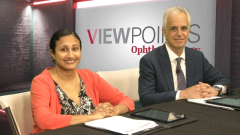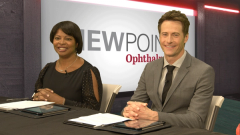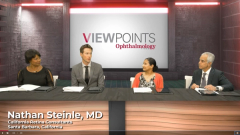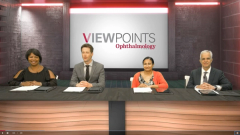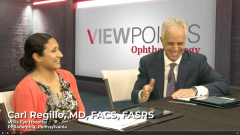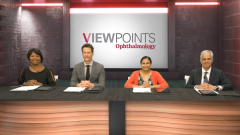
Approaches to Step Therapy in Neovascular AMD and DME
Adrienne Scott, MD, and Prethy Rao, MD, MPH, discuss implementation of step therapy in neovascular age-related macular degeneration and diabetic macular edema without compromising vision outcomes.
Episodes in this series

Nathan Steinle, MD: We have all this great clinical science, and we have to get it to our patients. Sometimes what’s standing in the way of us applying it to the patients is the insurers. We all say yes. A lot of times in these protocols, whether it’s for DME [diabetic macular edema] or for AMD [age-related macular degeneration], we have to go through step therapies, specifically in the off-label use of bevacizumab. What are your thoughts about bevacizumab? How do you approach step therapy?
Prethy Rao, MD, MPH: Protocol AC from the DRCR [Diabetic Retinopathy Clinical Research Network] shed a lot of light in terms of how we treat patients and requirements from insurers. I was very hopeful that Protocol AC demonstrated that. If you had to start with bevacizumab and ended up switching later, the outcomes in terms of vision were similar in both patient populations. I have that discussion with patients when we’re limited by their insurance to start with bevacizumab. That reassures patients that their vision outcome still can be very comparable if we end up starting with this vs a different agent.
Nathan Steinle, MD: Dr Regillo?
Carl Regillo, MD, FACS, FASRS: It’s reassuring to have a well-designed prospective study. It says that, on average, we’re probably not harming our patients starting with bevacizumab, a drug that’s obviously very inexpensive to use, that’s aliquoted and off-label intravitreally. But Protocol T definitively demonstrates that bevacizumab is not as effective as aflibercept. The premise is, should we start with aflibercept first, or can we switch? That’s how Protocol AC was designed over a 2-year time frame.
Over 2 years, 70% of patients got switched from bevacizumab to aflibercept. That’s a high percentage. Plus, when you look at the numbers in that study, the patients who started with aflibercept vs the switch arm from bevacizumab to aflibercept, had almost 2 fewer treatments in the aflibercept arm. From the individual patient standpoint, getting drier faster with fewer injections is attractive. Patients need to know that if we’re forced to go with bevacizumab first, it may result in more treatment and may ultimately switch, but also more injections to get to the same end point of vision gains and retaining those gains.
Nathan Steinle, MD: I agree. That 70% switch definitely caught my eye too.
Prethy Rao, MD, MPH: Yes.
Nathan Steinle, MD: Yes, for sure. How about in Baltimore? You’re next to Washington, DC. Can you teach me about the step therapies you have to deal with there?
Adrienne Scott, MD: I lean heavily on the DRCR Protocol T to guide my DME treatment. But insurance payers have other things in mind. Everybody understands that. The patient understands that. I feel comfortable, with the results of Protocol AC, starting with bevacizumab. It’s OK. We’re not harming anyone. I agree with what Dr Regillo was explaining that bevacizumab is a fine drying agent. However, it has to be given frequently. It’s counterintuitive to what we’re trying to do for our patients, which is to decrease their treatment burden. It’s nice to know that you’re not harming the patient. I’m not worried if the payer is mandating me starting with the bevacizumab. But I feel a little more uncomfortable using it in patients with poorer vision at baseline. Knowing what I know based on Protocol T, they would likely benefit from a more powerful drying agent.
Carl Regillo, MD, FACS, FASRS: That’s changing because we’re getting better-drying drugs. Protocol AC was using aflibercept, the best-drying drug at the time. But faricimab looks better. Even brolucizumab, which is FDA approved for DME, is a better-drying drug. Maybe that would translate to even fewer injections. Time to dry again is faster with the better-drying drugs, so that could be less treatment. There’s some cost savings to that too. Of course, this is all done because of cost savings. It’s same thing with biosimilars and so forth.
Adrienne Scott, MD: Think about what are we’re saving. We’re saving the cost of the medication, but that’s a patient who has to take time away from their work, family, and job, and this has a high treatment burden. What are we saving and for whom? What does that equal in the long term?
Nathan Steinle, MD: Those are good points.
Transcript edited for clarity
Newsletter
Keep your retina practice on the forefront—subscribe for expert analysis and emerging trends in retinal disease management.

